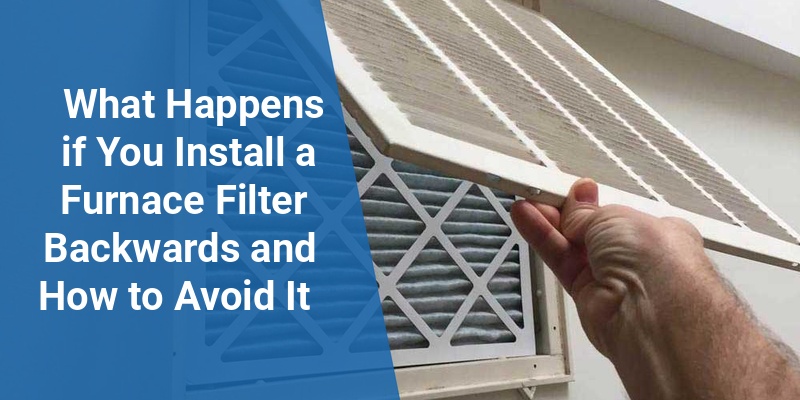Installing a furnace filter correctly is crucial for maintaining indoor air quality and ensuring your HVAC system runs efficiently. But what happens if the furnace filter is put in backwards? This common mistake can lead to reduced filtration effectiveness, increased energy use, and potential damage to your heating and cooling system. This article explains the consequences of reversing your furnace filter, how to identify the correct orientation, and tips for proper filter installation to keep your system operating smoothly.
| Key Aspect | Effect of Installing Furnace Filter Backwards |
|---|---|
| Air Flow | Restricted and uneven airflow leading to strain on the system |
| Filtration Efficiency | Significantly reduced, allowing dust and allergens to circulate |
| Energy Consumption | Increased as the system works harder to pull air through the filter |
| System Longevity | Potential premature wear and damage due to strain and debris |
| Indoor Air Quality | Degraded, which can affect health and comfort |
Why Furnace Filter Orientation Matters
Furnace filters are designed with a specific airflow direction marked by arrows on the filter frame. The filtered air flows from the return vent through the filter and into the blower. Installing the filter backwards disrupts this intended airflow, reducing its ability to trap dust and contaminants effectively. Filters use different materials arranged in layers, optimized to capture particles efficiently from the incoming air. When reversed, these layers do not function as designed, allowing pollutants to bypass the filter or clog the system prematurely.
Impact of Installing a Furnace Filter Backwards
Reduced Airflow and Increased System Strain
When a furnace filter is installed backwards, airflow faces resistance due to the filter media’s incorrect orientation. This causes the HVAC system to work harder to pull air through, increasing energy consumption and potentially leading to overheating or system failures.
Lower Filtration Efficiency
The design of the filter’s mesh and pleats are arranged to trap particles flowing from one direction. Reversal means dust, pollen, and other particulates can pass through unfiltered, degrading indoor air quality. For individuals with allergies or respiratory issues, this can worsen symptoms.
Potential Damage to Furnace Components
Increased strain on the blower motor and restricted airflow can cause the furnace to overheat. Over time, this leads to premature wear or damage to components like the heat exchanger and blower motor. Additionally, unrestricted dust passing through may accumulate on sensitive parts, reducing efficiency and increasing maintenance costs.
Identifying the Correct Filter Installation
Most furnace filters have an arrow printed on the frame pointing toward the furnace or air handler. This arrow indicates the direction the air flows. The correct orientation is with the arrow pointing toward the blower and away from the return air duct. Before installation, check your HVAC system or the filter manufacturer’s instructions to confirm the proper direction.
Tips to Ensure Proper Installation
- Locate the airflow arrow on the filter frame before installing.
- Confirm that the arrow points toward the blower or furnace, not the return duct.
- Handle the filter carefully to avoid damaging the pleats, which affects performance.
- Replace filters regularly according to manufacturer recommendations, usually every 1-3 months.
How to Correct a Backwards Furnace Filter Installation
If a furnace filter is installed backwards, the best solution is to turn off your HVAC system before removing and reinstalling the filter with the arrow pointing correctly. Running the system with a backward-installed filter even briefly can allow dust and debris to infiltrate the system.
Call 888-906-9139 for Free Local HVAC Quotes – No Obligation, Just Savings!
After correcting the installation, consider inspecting and cleaning the system for accumulated dust to restore optimal function and air quality.
Types of Furnace Filters and Sensitivity to Installation
Not all filters react the same way when installed backwards. Here are common types:
| Filter Type | Description | Impact if Installed Backwards |
|---|---|---|
| Fiberglass | Basic filter capturing large particles | Reduced efficiency; still somewhat functional but not optimal |
| Pleated | Higher efficiency with folded layers for more surface area | Significant drop in filtration; potential airflow restriction |
| HEPA | High efficiency particulate filters | Severe airflow restriction and compromised filtration |
Preventative Maintenance Tips for Furnace Filters
Regular furnace filter maintenance is critical to preventing problems from incorrect installations and ensuring home comfort.
- Set reminders to check and replace filters every 1-3 months.
- Inspect filters visually for dirt buildup and tears before reinstalling.
- Keep a spare filter on hand for timely replacement.
- Schedule professional HVAC inspections annually to assess system health.
- Educate household members on the importance of proper filter installation.
Signs Your Furnace Filter May Be Installed Backwards
- Decreased HVAC system airflow or weaker air output
- Higher than normal utility bills due to system inefficiency
- Unusual noises from the furnace or blower motor
- Increased dust accumulation on vents and surfaces
- Frequent furnace cycling or overheating
Conclusion
Correct furnace filter orientation is key to maintaining efficient HVAC performance, energy savings, and healthy indoor air quality. Installing a filter backwards reduces filtration efficiency, strains your system, and can cause costly damage. By paying close attention to filter arrows and following routine maintenance, homeowners can ensure their furnace operates effectively and their indoor environment remains clean and comfortable.
